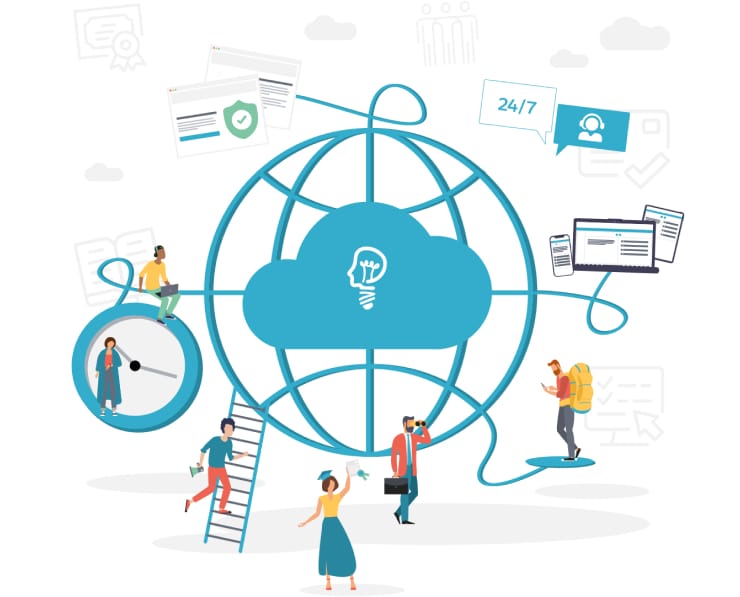Student Feedback
PL-900: Microsoft Power Platform Fundamentals Certification Video Training Course Outline
Introduction
Power BI Desktop - Visualizations
Power BI Desktop - Managing Data
Power BI Service
Installing Power Apps and Enviro...
The Dataverse (Common Data Service)
Creating PowerApps canvas app
Building a basic model-driven app
Creating PowerApps portal
Power Automate - connectors, tri...
Power Virtual Agents
Other Power Platform Topics
Introduction
PL-900: Microsoft Power Platform Fundamentals Certification Video Training Course Info
Microsoft Power Platform Training: PL-900 Fundamentals for Beginners
Explore Microsoft’s PL-900 exam topics, including Power Apps, Power Automate, Power BI, AI Builder, and the Dataverse (formerly Common Data Service).
What you will learn from this course
• Understand the business value and strategic benefits of Microsoft Power Platform for organizations of all sizes
• Explore and identify the core components of Power Platform, including Dataverse, Connectors, and AI Builder
• Gain hands-on experience in designing and building apps using Power Apps
• Learn to create automated workflows and processes with Power Automate
• Develop and manage conversational chatbots using Power Virtual Agents
• Demonstrate the capabilities and use cases of Power BI for business analytics and reporting
• Understand how Power Platform integrates with other Microsoft services, applications, and business solutions
• Gain foundational knowledge required to prepare for the PL-900 Microsoft Power Platform Fundamentals exam
• Learn how to use free trials and developer editions to practice and apply Power Platform skills
• Build confidence in applying Power Platform concepts in real-world business scenarios
Learning Objectives
The primary goal of this course is to provide a strong foundation in Microsoft Power Platform. By the end of the course, learners will be able to:
• Describe the value proposition of Power Platform and how it drives digital transformation in organizations
• Identify the major components of Power Platform and explain their purpose and functionality
• Understand the Dataverse (formerly known as Common Data Service) and how it is used to store and manage data
• Build basic canvas and model-driven applications in Power Apps and connect them to different data sources
• Automate repetitive business processes using Power Automate, including workflows triggered by events or conditions
• Create simple AI-powered solutions using AI Builder and integrate them into Power Apps and automated processes
• Design and implement chatbots using Power Virtual Agents to improve customer support or internal workflows
• Utilize Power BI to visualize data, generate reports, and provide actionable insights for decision-making
• Apply best practices for Power Platform administration, security, and governance
• Prepare effectively for the PL-900 certification exam and understand the skills measured in the exam objectives
Target Audience
This course is designed for a wide range of learners who are interested in understanding Microsoft Power Platform and its practical applications:
• Beginners who want to start learning Microsoft Power Platform from scratch
• Business professionals who aim to enhance business processes and analytics using Power Platform tools
• IT professionals seeking foundational knowledge before pursuing more advanced Microsoft certifications
• Students preparing for the PL-900 Microsoft Power Platform Fundamentals exam
• Anyone interested in automating workflows, analyzing data, or creating business applications with minimal coding
• Business analysts, project managers, or team leads who want to gain insights into Power Platform capabilities
• Individuals seeking to improve their resumes and career opportunities by obtaining Microsoft certification
Requirements
This course is beginner-friendly and requires minimal prior experience with Microsoft applications. To successfully complete the course, learners should have:
• Basic computer skills and familiarity with operating a PC or laptop
• General knowledge of spreadsheets is helpful but not mandatory
• Access to Windows 7 SP1 or later, or an internet browser such as Edge or Chrome to use most of the apps covered in this course
• Windows 8, 10, or 11 is required to access Power BI Desktop; however, the Power BI Service can be used on other devices
• A willingness to explore new applications and invest time in practicing hands-on exercises
• Optional: an interest in pursuing Microsoft certification to validate knowledge and skills
Prerequisites
There are no strict prerequisites for this course. It has been specifically designed to be accessible to learners with no prior knowledge of Microsoft Power Platform. The only requirements are:
• Familiarity with basic computer operations and navigation
• Access to a supported device and internet connection to work with online apps and services
• A desire to understand how business solutions can be built, automated, and analyzed using Power Platform tools
• Motivation to practice using the free trial or developer editions of Power Platform to gain practical experience
Overview
Microsoft Power Platform is a suite of applications, connectors, and a data platform that enables users to build custom solutions, automate workflows, analyze data, and create intelligent apps without extensive coding knowledge. The platform is designed to help organizations transform their operations, improve productivity, and make data-driven decisions.
The Power Platform includes four primary components: Power Apps, Power Automate, Power BI, and Power Virtual Agents. Each of these tools serves a distinct purpose but works seamlessly together to provide a unified solution for business challenges.
Power Apps allows users to build custom applications using a low-code or no-code approach. Users can create canvas apps, which provide full control over the app design, or model-driven apps, which focus on data and process-driven applications. With Power Apps, organizations can solve business problems by creating apps that connect to data from various sources, including Dataverse, SharePoint, SQL Server, and other connectors.
Power Automate helps automate repetitive tasks and business processes. Users can design workflows that trigger based on specific events, automate approvals, send notifications, or integrate with other Microsoft services and third-party applications. By automating processes, businesses can save time, reduce errors, and ensure consistent execution of tasks.
Power BI is a powerful business intelligence tool that allows users to visualize and analyze data. With Power BI, users can create interactive reports and dashboards, enabling data-driven decision-making. Power BI connects to a variety of data sources and provides advanced analytics capabilities to uncover insights and trends.
Power Virtual Agents allows organizations to create intelligent chatbots to interact with customers or employees. These chatbots can answer frequently asked questions, assist with routine tasks, and integrate with other Power Platform apps to streamline business operations.
The Dataverse acts as the underlying data platform for Power Platform applications. It provides a secure and scalable way to store and manage data, ensuring that applications and processes can access consistent, reliable information. AI Builder adds intelligence to apps and workflows, enabling predictive insights, form processing, object detection, and other AI-driven capabilities without needing deep data science expertise.
Benefits of Learning Power Platform
By mastering Power Platform fundamentals, learners gain a competitive edge in the job market and enhance their ability to contribute to digital transformation initiatives. Businesses increasingly rely on low-code platforms to innovate faster and reduce dependency on traditional software development. Understanding Power Platform equips learners with skills to:
• Build customized business applications without extensive coding experience
• Automate complex workflows and reduce manual intervention in business processes
• Analyze and visualize data to support better decision-making
• Create intelligent solutions using AI Builder and chatbots
• Improve operational efficiency and productivity across teams
• Prepare for a globally recognized Microsoft certification that demonstrates their expertise
This course provides learners with structured guidance, practical exercises, and quizzes to reinforce understanding, ensuring they are ready to apply Power Platform concepts in real-world scenarios. Students will also learn how to access free trials and developer editions to practice and gain hands-on experience, preparing them effectively for the PL-900 certification exam.
Course Modules / Sections
This course is organized into several structured modules to ensure learners gain a thorough understanding of Microsoft Power Platform and its components. Each module focuses on specific tools, concepts, and hands-on activities to build practical knowledge and prepare for the PL-900 certification exam.
The first module introduces Microsoft Power Platform and its core components, including Power Apps, Power Automate, Power BI, Power Virtual Agents, Dataverse, and AI Builder. Learners will explore the overall architecture of Power Platform and understand how these components integrate with each other to create end-to-end business solutions.
The second module focuses on Power Apps. This section introduces learners to canvas and model-driven apps, providing detailed guidance on creating applications from scratch. Learners will gain practical experience using connectors to integrate data from various sources, including Dataverse, SharePoint, and other cloud-based or on-premises databases. The module also demonstrates how to design app layouts, configure controls, and apply business logic using low-code development techniques.
The third module covers Power Automate, where learners explore workflow automation and task management. This section includes creating automated flows triggered by events, designing approval processes, and using conditional logic to streamline repetitive tasks. Learners will also understand how Power Automate integrates with other Microsoft services, such as Outlook, Teams, and SharePoint, to improve organizational efficiency.
The fourth module introduces Power BI, providing an overview of business intelligence concepts and data analytics. Learners will explore Power BI Desktop and Power BI Service, learning how to connect to various data sources, transform data using Power Query, create visualizations, and develop interactive dashboards. The module also emphasizes best practices for data modeling and sharing reports with stakeholders.
The fifth module focuses on Power Virtual Agents, teaching learners to build intelligent chatbots for customer service or internal business processes. Learners will explore conversation design, integrating chatbots with other Power Platform components, and applying AI models to enhance chatbot capabilities.
The sixth module covers Dataverse, the underlying data platform for Power Platform applications. Learners will understand how to create and manage tables, relationships, and business rules to support application logic. This module also includes guidance on security, data governance, and compliance considerations.
The seventh module introduces AI Builder, where learners explore prebuilt AI models, including object detection, form processing, prediction, and text recognition. Learners will learn how to integrate these models into Power Apps and Power Automate to enhance automation and decision-making.
The final module provides guidance on preparing for the PL-900 certification exam. Learners will review key exam objectives, practice with scenario-based exercises, and use quizzes to reinforce learning. The course concludes with strategies for applying Power Platform skills in real-world business scenarios.
Key Topics Covered
This course covers all foundational concepts and practical skills required for Microsoft Power Platform Fundamentals certification. Key topics include:
• Overview of Microsoft Power Platform and its business value
• Introduction to Dataverse, including table creation, relationships, and data storage
• Understanding connectors and integration options for connecting to various data sources
• Introduction to Power Apps: canvas apps, model-driven apps, and basic app design
• Designing forms, screens, and user interfaces within Power Apps
• Applying business logic, formulas, and automation in Power Apps
• Using Power Automate to create workflows, approvals, and process automation
• Integrating Power Automate with other Microsoft services and external applications
• Introduction to Power BI: connecting to data sources, data transformation, and data modeling
• Creating visualizations, interactive dashboards, and reports in Power BI
• Exploring Power Virtual Agents and designing intelligent chatbots
• Integrating AI Builder models into Power Apps and Power Automate for enhanced functionality
• Security and governance in Power Platform, including user roles, permissions, and compliance
• Best practices for deploying, managing, and maintaining Power Platform solutions
• Preparing for the PL-900 certification exam, including exam objectives, practice scenarios, and tips for success
The course also emphasizes hands-on practice and real-world examples to help learners understand how each component of Power Platform works individually and collectively. By covering these topics in depth, learners will be equipped with the skills necessary to build practical business solutions and gain confidence for the PL-900 exam.
Teaching Methodology
The teaching methodology in this course combines theoretical instruction with practical, hands-on learning to ensure learners gain both conceptual understanding and applied skills.
Instruction begins with clear explanations of concepts and terminology, providing learners with a solid foundation for understanding Power Platform. Lectures are designed to simplify complex topics and demonstrate real-world applications. Each concept is illustrated with examples that highlight practical use cases in business scenarios.
Hands-on exercises form a core part of the teaching methodology. Learners will work within Power Apps, Power Automate, Power BI, and Power Virtual Agents to apply the concepts covered in lectures. By completing step-by-step guided exercises, learners gain confidence in building applications, automating workflows, analyzing data, and creating chatbots. These exercises are designed to simulate real-world challenges, giving learners experience in problem-solving and decision-making.
Interactive learning tools, such as quizzes and scenario-based exercises, are used throughout the course to reinforce knowledge. These activities help learners retain key concepts, assess understanding, and prepare for exam-style questions. Feedback from quizzes allows learners to identify areas that require further review and improvement.
The course also emphasizes best practices and professional techniques for using Power Platform. Learners will explore effective app design, workflow optimization, data modeling strategies, and AI integration techniques. Instruction includes guidance on managing security, permissions, and governance to ensure solutions are reliable, scalable, and compliant with organizational policies.
Supplemental resources, including downloadable materials, templates, and links to Microsoft documentation, are provided to support continued learning outside of lectures. Learners are encouraged to practice with free trial accounts and developer editions to reinforce their skills and gain hands-on experience.
Overall, the teaching methodology is structured to provide a comprehensive learning experience that balances theory, practice, and assessment. Learners will finish the course with practical skills and a deep understanding of Power Platform capabilities, ready to apply them in real business scenarios or pursue PL-900 certification.
Assessment & Evaluation
Assessment and evaluation in this course are designed to ensure learners gain a thorough understanding of Microsoft Power Platform and are well-prepared for the PL-900 certification exam. The course includes a variety of assessment methods to evaluate knowledge, skills, and practical application.
Quizzes are embedded throughout the modules to test comprehension of key concepts. These quizzes cover topics such as Power Apps design, Power Automate workflows, Power BI visualizations, chatbot creation, Dataverse configuration, and AI Builder integration. Quizzes provide instant feedback, helping learners identify areas that need further review and reinforcing learning objectives.
Scenario-based exercises are an essential component of evaluation. Learners will be presented with real-world business scenarios and asked to develop solutions using Power Platform tools. These exercises assess practical skills, including app creation, workflow automation, data analysis, chatbot design, and AI integration. By completing these exercises, learners demonstrate their ability to apply theoretical knowledge to solve business problems effectively.
Practical projects serve as a capstone for each module, enabling learners to combine multiple Power Platform components into cohesive solutions. Projects may include designing a full app in Power Apps with integrated workflows, data analysis, and AI functionality, or creating a chatbot to handle customer inquiries with automated responses. These projects reinforce applied skills and build confidence in using Power Platform tools in professional settings.
Progress tracking and self-assessment are encouraged throughout the course. Learners can monitor their completion of modules, exercises, and quizzes, allowing them to identify strengths and areas for improvement. Reflection exercises help learners consolidate knowledge and prepare for practical application in real-world scenarios.
The course also provides guidance on exam preparation, including practice tests aligned with PL-900 objectives. These practice tests simulate the structure and content of the official certification exam, giving learners the opportunity to assess readiness and build confidence. Additional tips and strategies for passing the exam are provided, ensuring learners are well-prepared for certification success.
Evaluation emphasizes both knowledge acquisition and practical application, ensuring learners develop a comprehensive understanding of Power Platform. By completing assessments, quizzes, scenario exercises, and projects, learners will gain confidence in using Power Platform tools, applying best practices, and demonstrating competency for PL-900 certification.
This assessment methodology ensures that learners leave the course not only with theoretical understanding but also with the hands-on experience required to succeed in real-world business environments. Learners will be capable of creating effective applications, automating workflows, analyzing data, building intelligent chatbots, and integrating AI solutions to enhance business operations.
Benefits of the Course
This course provides learners with a comprehensive understanding of Microsoft Power Platform and equips them with the skills to effectively use its components in real-world business environments. One of the primary benefits is that learners gain hands-on experience with Power Apps, Power Automate, Power BI, Power Virtual Agents, Dataverse, and AI Builder. This practical experience allows learners to build functional applications, automate workflows, analyze business data, and create intelligent chatbots without extensive coding knowledge.
Another significant benefit is career advancement. As organizations increasingly adopt low-code platforms to streamline operations, individuals with Power Platform skills are in high demand. By completing this course, learners can enhance their professional profiles and increase employability. The PL-900 certification, which this course prepares students for, is globally recognized and demonstrates foundational expertise in Power Platform fundamentals.
The course also enables learners to develop problem-solving skills by applying Power Platform tools to real-world scenarios. For instance, learners will understand how to create a canvas app to manage employee data, automate approval workflows, analyze sales data in Power BI, or build a chatbot to assist with customer inquiries. These practical applications ensure that learners can translate theoretical knowledge into actionable solutions in business environments.
Learners will also gain familiarity with Microsoft’s Dataverse, which provides a secure and scalable data platform for storing and managing data. Understanding Dataverse is critical because it supports Power Apps, Power Automate, and AI Builder, allowing learners to develop integrated solutions.
AI Builder integration is another benefit, as learners will explore prebuilt AI models such as object detection, form processing, business card reading, and predictive models. This exposure to AI-powered capabilities enhances the learner’s ability to implement intelligent business solutions.
The course emphasizes best practices for app design, workflow automation, and data visualization. Learners will understand security configurations, permissions, and governance within Power Platform, ensuring that the solutions they build are secure, compliant, and scalable.
By the end of the course, learners will have a solid understanding of Power Platform’s capabilities, hands-on experience with all core tools, and readiness to take the PL-900 certification exam. These benefits combine to provide both immediate practical skills and long-term career advantages in IT, business analysis, data analysis, and digital transformation roles.
Course Duration
The course is structured to provide a comprehensive learning experience while being flexible enough to accommodate learners with varying schedules. The total duration is approximately 20 to 25 hours, which includes video lectures, hands-on exercises, quizzes, and scenario-based practice.
Video lectures are divided into short, focused segments ranging from five to fifteen minutes each. This modular approach allows learners to focus on specific topics, such as Power Apps design, workflow automation in Power Automate, or data visualization in Power BI, without feeling overwhelmed.
Hands-on exercises are embedded throughout the course and typically require 10 to 20 minutes per activity. These exercises are designed to reinforce learning, allowing learners to immediately apply concepts and tools covered in lectures. For instance, building a sample canvas app in Power Apps, creating a flow in Power Automate, or designing a dashboard in Power BI.
Scenario-based exercises simulate real-world business challenges and require longer engagement, often 30 to 45 minutes per activity. These exercises are critical for developing problem-solving skills and understanding how to integrate multiple components of Power Platform into cohesive solutions.
Quizzes are interspersed throughout the modules and take approximately 5 to 10 minutes each. They serve as checkpoints to assess comprehension and reinforce key concepts. Completing all quizzes and exercises ensures that learners are actively engaged and retaining knowledge.
The course also includes optional practice tests aligned with the PL-900 certification objectives. These practice tests typically take one to two hours to complete and help learners evaluate their readiness for the official exam.
Learners can progress at their own pace, making the course suitable for both full-time students and working professionals. The combination of lecture content, practical exercises, quizzes, and practice tests ensures that learners develop a well-rounded understanding of Power Platform within the estimated duration of 20 to 25 hours.
Tools & Resources Required
To successfully complete this course, learners will need access to specific tools and resources. The course primarily uses Microsoft Power Platform applications, many of which can be accessed through free trials or developer editions provided by Microsoft.
For Power Apps and Power Automate, learners will need a Microsoft account to access the online platform. Free Developer editions or trial accounts are sufficient for completing exercises and building sample apps and workflows. These accounts allow learners to explore all essential features without requiring a paid subscription.
Power BI is a critical tool in the course, and learners will need access to Power BI Desktop, which can be installed on Windows 8, 10, or 11. Alternatively, Power BI Service can be accessed through a web browser on other devices. Learners will use Power BI to connect to various data sources, transform data, create visualizations, and develop interactive dashboards.
Power Virtual Agents is accessed online and requires a Microsoft account as well. Learners will use this platform to design chatbots, create conversation flows, and integrate AI models.
AI Builder is available within the Power Apps and Power Automate environments. Learners will explore prebuilt AI models, including prediction, object detection, form processing, and text recognition models. No advanced AI knowledge is required, as the course provides step-by-step guidance on using these tools.
A modern web browser such as Microsoft Edge or Google Chrome is recommended for accessing most of the applications used in this course. This ensures compatibility and smooth operation of all online tools.
For storing sample data and exploring Dataverse, learners will use trial or developer environments provided by Microsoft. This enables hands-on practice with creating tables, relationships, and business rules within the Dataverse environment.
Additional resources, such as downloadable templates, practice files, and reference materials, are provided to support learning. These resources help learners complete exercises efficiently and provide reference points for revisiting key concepts.
Basic computer skills and familiarity with spreadsheet operations are required. Learners should be comfortable navigating their operating system, managing files, and using web applications. This foundation allows learners to focus on building skills within Power Platform without being hindered by technical difficulties.
Internet connectivity is required for accessing online applications, downloading tools, and completing hands-on exercises. A stable connection ensures smooth interaction with Power Platform applications and avoids interruptions during practical exercises.
The course is designed to be accessible and beginner-friendly, so no prior experience with Power Platform is needed. The combination of online access, trial accounts, and provided resources ensures that learners can complete all exercises and projects successfully.
By providing the necessary tools and resources, learners are equipped to explore Power Platform comprehensively, gain practical experience, and develop the skills required for the PL-900 certification exam.
Career Opportunities
Completing this course opens a wide range of career opportunities for professionals looking to build skills in Microsoft Power Platform. The increasing adoption of low-code platforms by organizations across industries has created high demand for individuals with expertise in Power Platform components such as Power Apps, Power Automate, Power BI, Power Virtual Agents, Dataverse, and AI Builder.
One of the most common career paths is becoming a Power Platform Developer. In this role, professionals design, build, and maintain applications using Power Apps and integrate workflows with Power Automate. They create solutions that help organizations automate processes, improve efficiency, and reduce operational costs. Developers also work on integrating Power Platform applications with other Microsoft services, such as Microsoft 365, Dynamics 365, SharePoint, and Teams.
Business analysts can benefit significantly from this course. With skills in Power BI, they can analyze data, generate insights, and create interactive reports and dashboards to support data-driven decision-making. Knowledge of Power Automate allows them to design automated workflows that improve business processes, while Power Apps enables them to create applications that meet specific organizational needs without extensive coding.
IT administrators and solution architects can leverage their knowledge of Power Platform to design and manage enterprise solutions. These roles involve overseeing the deployment, security, and governance of Power Platform applications, ensuring compliance with organizational policies and industry regulations. Understanding Dataverse, security models, and AI Builder integration enhances the ability to manage complex solutions and maintain system reliability.
Another promising career opportunity is in the field of process automation and digital transformation. Professionals in these roles focus on identifying areas for improvement in business workflows and implementing solutions using Power Platform tools. Automation specialists use Power Automate to streamline repetitive tasks, reduce errors, and increase productivity, contributing to organizational efficiency.
Professionals can also pursue roles as chatbot developers using Power Virtual Agents. In this capacity, they design intelligent conversational agents for customer service, internal support, and operational tasks. These chatbots enhance user experience, reduce workload on human agents, and provide 24/7 assistance. Integration with AI Builder further allows these chatbots to perform advanced functions, including predictions, object detection, and text recognition.
Career growth in Power Platform-related roles is enhanced by certification. The PL-900 Microsoft Power Platform Fundamentals certification demonstrates foundational knowledge and skills, making candidates more attractive to employers. It serves as a stepping stone for advanced certifications, such as PL-200 (Power Platform Functional Consultant), PL-400 (Power Platform Developer), and PL-600 (Power Platform Solution Architect), which further expand career opportunities and potential earning power.
This course equips learners with practical skills, hands-on experience, and foundational knowledge needed to succeed in these roles. Professionals who complete this course will be able to contribute immediately to projects involving process automation, app development, data analysis, and AI integration. They will also gain confidence in applying Power Platform solutions in real-world scenarios, making them valuable assets to their organizations.
Industries benefiting from Power Platform expertise include finance, healthcare, retail, manufacturing, education, and government. Organizations in these sectors increasingly rely on low-code platforms to improve operations, automate workflows, and enhance decision-making capabilities. As a result, professionals with Power Platform skills are in high demand and can pursue careers across diverse sectors, enhancing job security and professional growth.
Freelancing and consulting opportunities are also available for individuals with Power Platform expertise. Professionals can offer services in app development, workflow automation, data analysis, and chatbot creation for clients who need customized solutions but lack in-house expertise. This provides flexibility and the potential for higher income through project-based work.
The combination of technical skills, business understanding, and certification significantly increases career prospects. Professionals who can demonstrate proficiency in Power Platform tools, practical problem-solving, and automation will have an advantage in the job market. Organizations value employees who can create solutions that save time, reduce costs, and improve productivity, making the skills gained from this course highly valuable.
Conclusion
This course provides a comprehensive foundation in Microsoft Power Platform and prepares learners to achieve the PL-900 certification. By covering the core components—Power Apps, Power Automate, Power BI, Power Virtual Agents, Dataverse, and AI Builder—learners gain both theoretical knowledge and practical skills that can be applied in real-world business scenarios.
Learners start by understanding the strategic value of Power Platform and how it drives digital transformation. They explore each component in depth, learning to create applications, automate workflows, analyze data, and build intelligent chatbots. Hands-on exercises, scenario-based projects, and quizzes reinforce learning and ensure learners can apply concepts effectively.
The course also emphasizes best practices for security, governance, and data management. Understanding these principles ensures that solutions are reliable, scalable, and compliant with organizational standards. AI integration through AI Builder enhances applications and workflows, providing intelligent solutions without requiring extensive coding knowledge.
Career opportunities abound for learners who complete this course. From Power Platform developers and business analysts to IT administrators, solution architects, and automation specialists, the skills gained open doors to diverse roles across multiple industries. PL-900 certification further validates expertise, boosting employability and providing a pathway to advanced certifications and higher-level roles.
The structured modules, comprehensive coverage, and hands-on learning make this course suitable for beginners and professionals alike. No prior experience with Power Platform is required, and learners are guided through each step to build confidence and competence. Access to trial accounts and developer editions ensures practical experience with minimal cost, allowing learners to explore and experiment with all tools covered in the course.
By completing this course, learners will be able to:
• Understand the business value and components of Power Platform
• Build and manage apps using Power Apps
• Automate workflows and processes with Power Automate
• Analyze data and create interactive dashboards in Power BI
• Design and implement chatbots using Power Virtual Agents
• Work with Dataverse to store, manage, and secure data
• Integrate AI Builder models for intelligent business solutions
• Apply best practices for security, governance, and compliance
• Prepare effectively for the PL-900 certification exam
• Enhance career prospects and pursue opportunities in various roles and industries
The practical skills, knowledge, and certification gained from this course empower learners to contribute effectively to digital transformation initiatives in their organizations. Learners will be equipped to solve real business problems, improve operational efficiency, and leverage data-driven insights to support decision-making.
Enroll Today
Enroll today in this comprehensive Microsoft Power Platform Fundamentals course and take the first step toward mastering the tools that drive modern business solutions. Gain practical skills, hands-on experience, and certification readiness to advance your career. By completing this course, you will be prepared to implement real-world solutions, pursue PL-900 certification, and explore numerous professional opportunities in Power Platform development, business analysis, automation, and data analytics.
Unlock your potential, enhance your resume, and gain the knowledge and skills required to succeed in today’s fast-paced, technology-driven business environment. Start your journey with Microsoft Power Platform today and join the growing community of certified professionals who are shaping the future of digital transformation.













